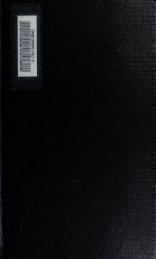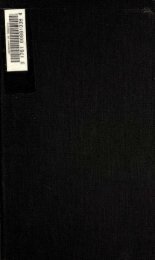Texts from the Buddhist canon : commonly known as Dhammapada
Texts from the Buddhist canon : commonly known as Dhammapada
Texts from the Buddhist canon : commonly known as Dhammapada
Create successful ePaper yourself
Turn your PDF publications into a flip-book with our unique Google optimized e-Paper software.
INTRODUCTION. n<br />
<strong>the</strong>y are faithful versions of works everywhere <strong>known</strong> ia<br />
India, not only duriag <strong>the</strong> early period of its history, but<br />
also throughout its development—or, to put it into plain<br />
figures, <strong>the</strong> books found in China afford us a consecutive<br />
catena of writings dating <strong>from</strong> at le<strong>as</strong>t lOO B.C. to 600 A.D.,<br />
that is, during a period of 700 years. More than this can<br />
scarcely be desired for a perfect study of any religious<br />
system.<br />
We come now to a comparison of this earliest transla-<br />
tion with that <strong>from</strong> <strong>the</strong> P§,li. The Fa-kheu-king contains<br />
thirty-nine chapters against <strong>the</strong> twenty-six of <strong>the</strong> Sou<strong>the</strong>rn<br />
edition, and 760^ stanz<strong>as</strong> against 423. "We are told, how-<br />
ever, in <strong>the</strong> preface that <strong>the</strong> original work consisted of<br />
twenty-six chapters and 500 stanz<strong>as</strong> ; and <strong>as</strong> in <strong>Buddhist</strong><br />
calculations <strong>the</strong> next highest round number is frequently<br />
used to denote <strong>the</strong> exact number intended, we have in this<br />
statement sufficient Evidence to show that <strong>the</strong> original<br />
<strong>from</strong> which our translation w<strong>as</strong> made consisted of <strong>the</strong><br />
same chapters, and probably <strong>the</strong> same number of verses,<br />
<strong>as</strong> that <strong>known</strong> in <strong>the</strong> South— in o<strong>the</strong>r words, that <strong>the</strong>y<br />
were identical. If so, <strong>the</strong> question arises. Who added <strong>the</strong><br />
thirteen additional sections? It would appear <strong>from</strong> <strong>the</strong><br />
wording' of <strong>the</strong> preface that this w<strong>as</strong> <strong>the</strong> work of <strong>the</strong><br />
Indian missionary (or refugee) Tsiang-im, who added<br />
<strong>the</strong>se sections after due consultation \tsze wan], tak-<br />
ing care , to verify <strong>the</strong>m <strong>from</strong> ancient sources. If this<br />
be so (<strong>the</strong> p<strong>as</strong>sage is confessedly obscure), it would, lead<br />
us to suppose that <strong>the</strong> original manuscript brought<br />
to China w<strong>as</strong> <strong>the</strong> same <strong>as</strong> that <strong>known</strong> ia Ceylon, <strong>the</strong><br />
differences which occur between <strong>the</strong> two being attri-<br />
butable to special re<strong>as</strong>ons existing at <strong>the</strong> time of <strong>the</strong><br />
translation.<br />
^ In <strong>the</strong> preface it is stated that summary of stanz<strong>as</strong>—<strong>the</strong>re are five<br />
<strong>the</strong>re are only 752 stanz<strong>as</strong>. The verses more in <strong>the</strong> text than in <strong>the</strong><br />
difference between this and <strong>the</strong> sum index in that version, and in <strong>the</strong><br />
of <strong>the</strong> headings of each chapter must Chinese eight more {Vide M<strong>as</strong> Miilbe<br />
accidental. It is carious that a ler's Sh. ix. n.<br />
similar discrepancy occurs in <strong>the</strong> F&li<br />
)





